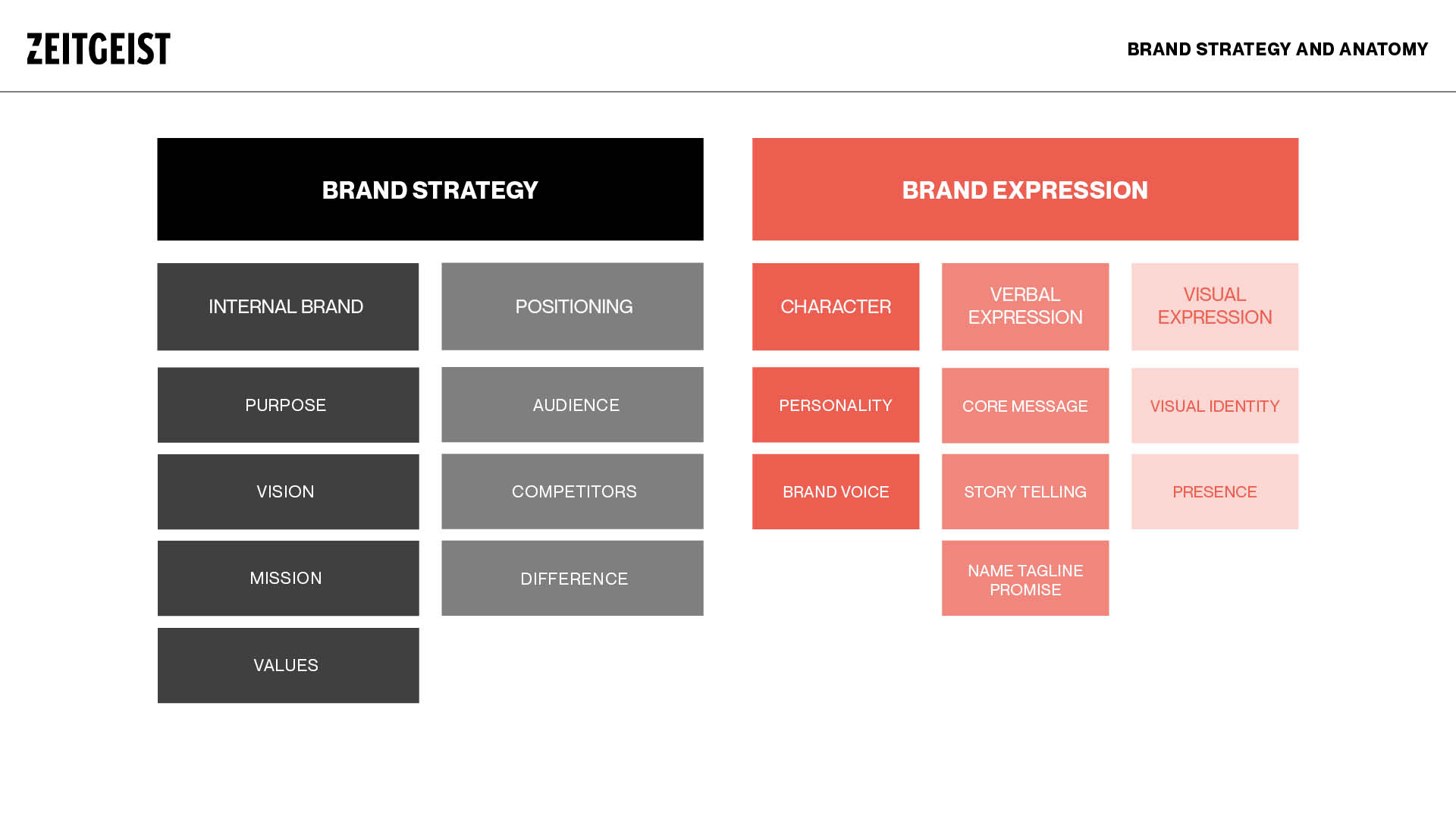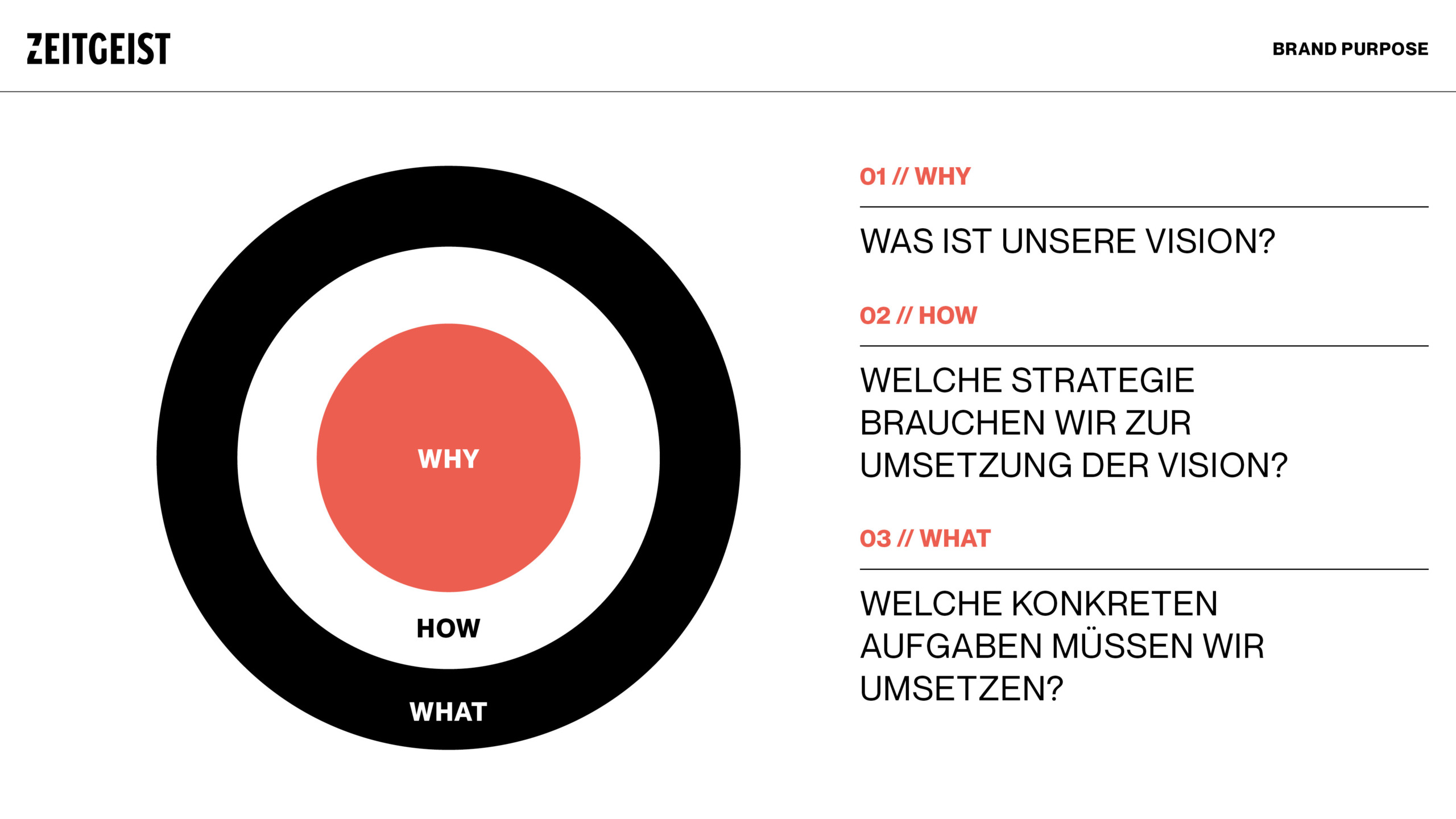Let’s say you’ve come to the difficult realization that your brand – if you can even call it that – is all messed up. Or worse, you have a defined brand, but you find that it doesn’t match who you really are and what you really do.
Don’t panic.
Before you start worrying about what shade of green to use for your logo or what tone you use to communicate with people on Twitter, take a step back and look at the big picture.
Definition
Brand strategy is a plan that includes specific, long-term goals that can be achieved by developing a successful brand – the combined components of your company’s character that make it identifiable.
(We’ll go into this in more detail in a moment).
A well-defined and executed brand strategy impacts all aspects of a business and is directly related to consumer needs, emotions and the competitive landscape.
First, let’s clear up the biggest misconception about brand strategy: your brand is not your product, your logo, your website, or your name.
In fact, your brand is much more than that – it’s what feels intangible. But it’s that elusive feeling that separates strong brands from mediocre ones.
To help you master what for many marketers is more of an art and less of a science, we’ve broken down seven essential components of a comprehensive brand strategy that will help your business last.
Anatomy
A successful brand strategy comes from a clear understanding of its anatomy. Below is a graphical overview of a brand, divided into Brand Strategy (left) and Brand Expression (right). The Brand Strategy should also be carried out in this order.

Internal Brand
The Internal Brand is the first block of the Brand Strategy. This is developed right at the beginning and is also the basis for everything else. Internal fire because it is only about the fire itself and its origin.
Purpose
The best definition I’ve heard is “a higher reason for a brand’s existence than just making a profit.” A good place to start is Simon Sinek’s work on the “why” of a brand.
Knowing the deeper “why” of your business or brand is the foundation upon which you can build everything else – your “how” (company culture, brand experience) and your “what” (what products or services you offer).

The clearest example I like to use is Tesla. This is Tesla’s original brand purpose:
Tesla’s mission is to accelerate the world’s transition to sustainable transportation.
How” they did this by creating a culture of technology, design and innovation driven by a gigantic ambition to move the world away from polluting fossil fuels. What” they created for it was a line of super cool electric vehicles and all the infrastructure (a network of charging stations, a huge Gigafactory to manufacture cost effective batteries) to support them.
As Tesla founder Elon Musk himself put it:
“Working long hours for a company is tough. Working long hours for a cause is easy.”
The people who work for Tesla are fueled by the sheer ambition behind the company’s brand purpose, which gives meaning to their work. Customers who buy Tesla vehicles are also drawn to the deeper “good” that comes from driving a super-cool electric vehicle: zero emissions to combat climate change, and being at the forefront of a clean energy revolution.
Vision Statement
Similar to a mission statement, a vision statement provides a concrete way for stakeholders, especially employees, to understand the purpose of your organization. However, unlike a mission statement – which describes the who, what and why of your company – a vision statement describes the desired long-term results of your company’s efforts. For example, an early vision statement from Microsoft was “a computer on every desk and in every home.”
“An organization’s vision statement reveals at the highest level what an organization most hopes to be and achieve in the long run,” says Katie Trauth Taylor, CEO of writing consultancy Untold Content. “It serves a somewhat lofty purpose – to focus all of the company’s foresight into one impactful statement.”
Why is this important? Research shows that employees who feel their company’s vision is meaningful have a 68% engagement rate, which is 18 points above average. More engaged employees are often more productive, and they are more effective ambassadors for the company in the larger community.
Considering the impact a vision statement can have on a company’s long-term success and even the bottom line, it’s worth taking the time to write a statement that summarizes your ambitions and mobilizes your employees.
Mission Statement
A mission statement defines what an organization is, why it exists, its raison d’être. At a minimum, your mission statement should define who your key customers are, identify the products and services you produce, and describe the geographic location where you operate.
If you don’t already have a mission statement, create one by writing down in one sentence what your company’s purpose is. Ask two or three of the most important people in your company to do the same. Then discuss the statements and find a sentence that everyone agrees with. Once you have completed your mission statement, communicate it to everyone in the company.
It is more important to communicate the mission statement to employees than to customers. Your mission statement doesn’t have to be clever or memorable, just precise.
If you already have a mission statement, you need to periodically review and possibly revise it to ensure that it accurately reflects your goals as your organization and the business and economic climate evolve. To do this, simply ask yourself if the statement still accurately describes what you are doing.
If your review results in a revision to the statement, make sure everyone in the company is aware of the change. Make it a big deal. After all, changing your mission likely means growing your business – and that’s a big deal.
Once you have designed a niche for your business, you are ready to create a mission statement. A mission statement is an important tool that can be just as important as your business plan. It summarizes in a few concise sentences the essence of your company’s goals and their underlying philosophies. Equally important, the mission statement signals to your customers, employees, suppliers and the community what your company is all about.
The mission statement reflects all facets of your business: the range and types of products offered, pricing, quality, service, market position, growth potential, use of technology, and relationships with your customers, employees, suppliers, competitors, and the community.
Values
Your brand core values are the beliefs you stand for as a company. They serve as a compass that guides your brand story, actions, behaviors and decision-making process.
There will be times in business when you have to make difficult decisions. But when you have core values that constantly remind you of what’s important to your business and the people you serve, making the right decision becomes an effortless task. And on top of that, you can live with these decisions knowing they are based on values that align with your brand’s overarching mission and vision.
Brand core values are important because they influence how consumers view your brand, which is important considering consumers are more likely to support a brand whose core values align with their own. The same is true for employees. In fact, several studies show that shared core values have a significant impact on employee engagement.
And the bottom line? By building your brand around your core values, you can build a company that you can be proud of and passionate about. And because these core values reflect you and your company, it’s much easier to stay true to yourself. And at a time when consumer trust is at an all-time low, it pays to have a core set of values that helps you maintain your brand’s authenticity.

Positioning
After the internal approach and the elaboration of the internal brand, it is necessary to turn the view to the outside. In the positioning section, we look at the market, specifically the target group and the current competition. Once you have developed an understanding of this, you need to successfully position your own brand there according to the USPs / differentiators.
A positioning is really nothing more than the perception in a customer’s mind of the brand in relation to existing brands.
Audience
The first thing to consider is the target audience. This step is crucial. The deeper you understand the target group. the better you can align the products, service or brand with them. If you’ve been in the market for several years, you probably already have insight into your target audience based on customer lists. In this case, it is necessary to evaluate the data and extract a desired target group from it.
For new brands, try to create an MVA (minimum viable audience). That is, to create the smallest possible, but still economically viable target group. Kevin Kelly also writes about this in his book “1000 True Fans” that you only need 1000 loyal followers or customers to be commercially successful. Of course, this is only a guideline and depends on the product or the target group.
However, it is an interesting and valid exercise to try to create a target audience that includes only 1000 people. In addition, you should know that this figure is the beginning. Expansion is usually the logical consequence of growth. However, you should try to be as concrete and specific as possible at the beginning.
Competitors
After knowing your target audience, it is necessary to know the competition or the competitor. Here, it is important to specifically work through and compare their strengths, weaknesses and market share. It is particularly interesting to understand which competitor appeals to which segment of the target group and why. By answering these questions, you get a very good picture of the overall market and how it came to be.
Difference
Ultimately, the key is how you differentiate yourself from the competition and how good you are at communicating that to the customer. This is referred to as USPs (Unique Selling Proposition) or differentiators. Translated, it means nothing else than how you are different from others and what advantages customers have with you in comparison.
Here you should make sure that the USP is really relevant. There are enough unique products, but they do not differ in the crucial aspects or offer the advantage.
Tips
Here are a few useful tips which can be very helpful in creating and developing a Brand Strategy.
Avoid the short-term trap
It’s easy to get caught up in the short-term activities and tactics that drive business today, but when it comes to building a brand, it’s a big mistake. Brands aren’t built overnight, so your brand strategy should focus on long-term goals and sustainable growth, not short-term tactics.
Admittedly, it’s hard to stay strategic when executives are crushed by data and demand immediate measurable growth and positive ROI. However, the best brand leaders fight against short-term focus because they know that shortsightedness is a brand killer.
Thomson Dawson, Managing Partner of PULL Brand Innovation, described this problem well in an article for Branding Strategy Insider earlier this year. He wrote:
“Agency brand managers and account planners are tactics-driven. This is because 80% of the daily processes in marketing departments and advertising agencies are based on project management. Creative Briefs are control documents rather than a forum for collecting inspiring ideas. Brand managers and their communications partners are focused on how best to manage the processes and tight budgets they have been allocated. They usually don’t think long-term when they are at the crossroads of strategic and creative decisions. They focus on getting a job done (on time and on budget). Add to that the changing priorities of senior management, and it’s easy to see how creative briefs become confusing.”
Instead of focusing on short-term tactics, Dawson urges becoming brand architects that allow teams to design a lasting structure “to connect brand strategy and brand message.” He’s absolutely right. Without a strong brand foundation built on a clearly defined strategy, brands have little chance of success. However, it’s hard to stick with that strategy and not be seduced by the lure of short-term focus.
Stay flexible
Of course, the best brands stick to their strategies, but those strategies leave room for flexibility as the market, consumers and competitors change. Think of it this way:
Just as your goals in life can change over time, so can your brand goals.
Just as you might change your plan to achieve your life goals, your brand marketing plan might change.
Finally, just as you take opportunities to move closer to your goals as they arise throughout your life, you will also take short-term opportunities to grow your brand and move closer to your long-term brand goals as those opportunities present themselves.
A specific, achievable brand strategy is an essential part of any business as it impacts every area of your organization. Stay tuned to the AYTM Blog for Part 2 of the Introduction to Brand Strategy series, where you’ll learn more about identifying stakeholders and developing your brand strategy.
Avoid
The top five reasons why some brands often fail at their brand strategy are:
- Lack of long-term vision.
- No consolidation of brand identity and message.
- Inconsistent creativity.
- No understanding of their ideal customer.
- Product-to-market fit that is now obsolete or never hit the target.
- Branding has to do with focusing your vision on an experience.
One problem I often see is when companies force the use of management workflows designed for analytical processes into creative work. Creative work should be built from “strategy frames,” which requires a completely different process.
Summary
A solid brand strategy is the basic prerequisite and foundation for building a successful brand. It precedes the development of an image & type logo, choice of fonts, colors and other visual elements. The better the brand strategy, the better the subsequent expression of the brand.





